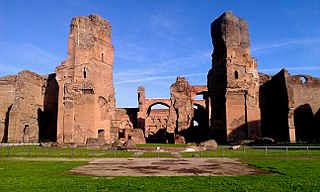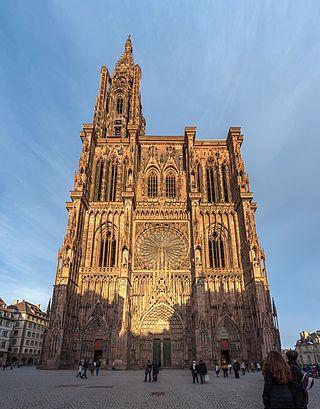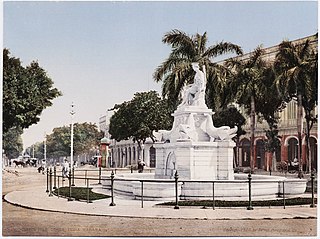
The Christ of Havana (Spanish: Cristo de La Habana) is a large sculpture representing Jesus of Nazareth, on a hilltop overlooking the bay in Havana, Cuba. It is the work of the Cuban sculptor Jilma Madera, who won the commission for it in 1953.

The Christ of Havana (Spanish: Cristo de La Habana) is a large sculpture representing Jesus of Nazareth, on a hilltop overlooking the bay in Havana, Cuba. It is the work of the Cuban sculptor Jilma Madera, who won the commission for it in 1953.
The statue was carved out of white Carrara marble, the same material used for many of the monuments of the Colon Cemetery. The statue is about 20 metres (66 ft) high including a 3-metre (10 ft) base. [1] It weighs approximately 320 tons. The statue was built from 67 blocks of marble that had been brought from Italy after being personally blessed by Pope Pius XII. The figure of Christ is standing with the right hand held near the chin and the left hand near his chest. Facing the city, the statue was left with empty eyes to give the impression of looking at all, from anywhere to be seen.
The sculpture, located in the Havana suburb of Casablanca, in the municipality of Regla, was inaugurated on La Cabaña hill on December 24, 1958. Just fifteen days after its inauguration, on January 8, 1959, Fidel Castro entered Havana during the Cuban Revolution.
The sculpture is located 51 metres (167 ft) above sea level, [2] rising to a height of 79 metres (259 ft), allowing the locals to see it from many points of the city. There is a panoramic viewpoint at the site of the sculpture.
Locals say that the statue is intended to depict Christ holding an imaginary cigar in the right hand, and a mojito in his left, honoring popular Cuban culture. Madera has said that the statue's facial features are intended to reflect the racial diversity of Cuba, and that its shoes were modelled on the flip-flops she wore while working in Italy. [3]

The Papal Basilica of Saint Peter in the Vatican City, or simply Saint Peter's Basilica, is a church of the Italian High Renaissance located in Vatican City, an independent microstate enclaved within the city of Rome, Italy. It was initially planned in the 15th century by Pope Nicholas V and then Pope Julius II to replace the ageing Old St. Peter's Basilica, which was built in the fourth century by Roman emperor Constantine the Great. Construction of the present basilica began on 18 April 1506 and was completed on 18 November 1626.

The Madonna della Pietà colloquially known as La Pietà is a Roman Catholic Italian Carrara marble sculpture of Jesus Christ and the Virgin Mary at Mount Golgotha, a subject in art known as the Pietà.

Milan Cathedral, or Metropolitan Cathedral-Basilica of the Nativity of Saint Mary, is the cathedral church of Milan, Lombardy, Italy. Dedicated to the Nativity of St. Mary, it is the seat of the Archbishop of Milan, currently Archbishop Mario Delpini.

The Baths of Caracalla in Rome, Italy, were the city's second largest Roman public baths, or thermae, after the Baths of Diocletian. The baths were likely built between AD 212 and 216/217, during the reigns of emperors Septimius Severus and Caracalla. They were in operation until the 530s and then fell into disuse and ruin.

Christ the Redeemer is an Art Deco statue of Jesus in Rio de Janeiro, Brazil, created by French-Polish sculptor Paul Landowski and built by Brazilian engineer Heitor da Silva Costa, in collaboration with French engineer Albert Caquot. Romanian sculptor Gheorghe Leonida sculpted the face. Constructed between 1922 and 1931, the statue is 30 metres (98 ft) high, excluding its 8-metre (26 ft) pedestal. The arms stretch 28 metres (92 ft) wide. It is made of reinforced concrete and soapstone. Christ the Redeemer differs considerably from its original design, as the initial plan was a large Christ with a globe in one hand and a cross in the other. Although the project organizers originally accepted the design, it later changed to the statue of today, with the arms spread out wide.

Strasbourg Cathedral or the Cathedral of Our Lady of Strasbourg, also known as Strasbourg Minster, is a Catholic cathedral in Strasbourg, Alsace, France. Although considerable parts of it are still in Romanesque architecture, it is widely considered to be among the finest examples of Rayonnant Gothic architecture. Architect Erwin von Steinbach is credited for major contributions from 1277 to his death in 1318, and beyond through his son Johannes von Steinbach, and his grandson Gerlach von Steinbach, who succeeded him as chief architects. The Steinbachs' plans for the completion of the cathedral were not followed through by the chief architects who took over after them, and instead of the originally envisioned two spires, a single, octagonal tower with an elongated, octagonal crowning was built on the northern side of the west facade by master Ulrich Ensingen and his successor, Johannes Hültz. The construction of the cathedral, which had started in the year 1015 and had been relaunched in 1190, was finished in 1439.

The Victor Emmanuel II National Monument, also known as the Vittoriano or Altare della Patria, is a large national monument built between 1885 and 1935 to honour Victor Emmanuel II, the first king of a unified Italy, in Rome, Italy. It occupies a site between the Piazza Venezia and the Capitoline Hill. The monument was realized by Giuseppe Sacconi.

The Salt Cathedral of Zipaquirá is an underground Roman Catholic church built within the tunnels of a salt mine 200 metres (660 ft) underground in a halite mountain near the city of Zipaquirá, in Cundinamarca, Colombia. It is a tourist destination and place of pilgrimage in the country. The temple at the bottom has three sections, representing the birth, life, and death of Jesus. The icons, ornaments and architectural details are hand carved in the halite rock. Some marble sculptures are included. The cathedral is considered one of the most notable achievements of Colombian architecture, being described as a "Jewel of Modern Architecture". The cathedral represents a valuable cultural, environmental and religious patrimony for the Colombian people.

Plaza de la Revolución, "Revolution Square", is a municipality and a square in Havana, Cuba.

The National Capitol of Cuba, also known as Capitolio Nacional de La Habana, and often simply referred to as El Capitolio(The Capitol), is a public edifice in Havana, the capital of Cuba. The building was commissioned by Cuban president Gerardo Machado and built from 1926 to 1929 under the direction of Eugenio Rayneri Piedra. It is located on the Paseo del Prado, Dragones, Industria, and San José streets in the exact center of Havana.

The Sanctuary of Christ the King is a Catholic monument and shrine dedicated to the Sacred Heart of Jesus Christ overlooking the city of Lisbon situated in Almada, in Portugal. It was inspired by the Christ the Redeemer statue of Rio de Janeiro, in Brazil, after the Cardinal Patriarch of Lisbon visited that monument. The project was inaugurated on 17 May 1959. The giant statue was erected to express gratitude because the Portuguese were spared the direct destructive effects of World War II.

The José Martí Memorial is a memorial to José Martí, a national hero of Cuba, located on the northern side of the Plaza de la Revolución in the Vedado area of Havana. It consists of a star-shaped tower, a statue of Martí surrounded by six columns, and gardens. It is the largest monument to a writer in the world.

Christ of the Abyss is a submerged bronze statue of Jesus Christ by Guido Galletti, the original cast of which is located in the Mediterranean Sea, off San Fruttuoso, between Camogli and Portofino on the Italian Riviera. Various other casts of the statue are located in other places worldwide, in underwater locations, churches and museums.

Lilia Jilma Madera Valiente was a well-known Cuban sculptor. Her two most famous works are the Christ of Havana and the bust of José Martí on the Pico Turquino, which is the highest peak of Cuba.

Cristo de la Concordia is a statue of Jesus Christ located atop San Pedro Hill, to the east of Cochabamba, Bolivia. It is accessible by cable car, or by climbing 2,000 steps. The statue is 33.44 metres (109.7 ft) tall, on a pedestal of 6.24 metres (20.5 ft), for a total height of 39.68 metres (130.2 ft).

The Statue of Christ the Redeemer of Maratea is a statue of Jesus Christ in Maratea, southern Italy, realized in Carrara marble on the top of the Mountain “St. Biagio".

Christ the King is a statue of Jesus Christ in Świebodzin, western Poland, completed on 6 November 2010. The figure is 33 metres (108 ft) tall, the crown is 2 metres (6.6 ft) tall, and along with its mound, it reaches 52.5 metres (172 ft) overall. It took five years in total to construct and cost around $1.5 million to build, which was collected from donations of the 21,000 residents of the town. The project was conceived and led by Sylwester Zawadzki, a retired Polish priest. It remains the tallest Jesus statue in the world according to the Guinness Book of World Records.
The Christ of the Mercy is a colossal statue of Jesus Christ in the city of San Juan del Sur, Nicaragua, to a height of 134m above sea level. The statue is located high above the northernmost seawall in the bay of San Juan. At the foot of the statue is a small chapel. Information: Inside the chapel, the full name of the work is provided, along with text dating the construction to 2009. As of January 2017, the entrance fee is $2 for foreigners and $1 for Nicaraguan nationals.

Fuente de la India is a fountain by Giuseppe Gaggini in Havana, Cuba, at the south extreme of Paseo del Prado, about 100 m south of El Capitolio, between Monte and Dragones Streets. The figure represents the Indian woman "Habana" in whose honor Havana was named.
23°08′38″N82°20′42″W / 23.14389°N 82.34500°W